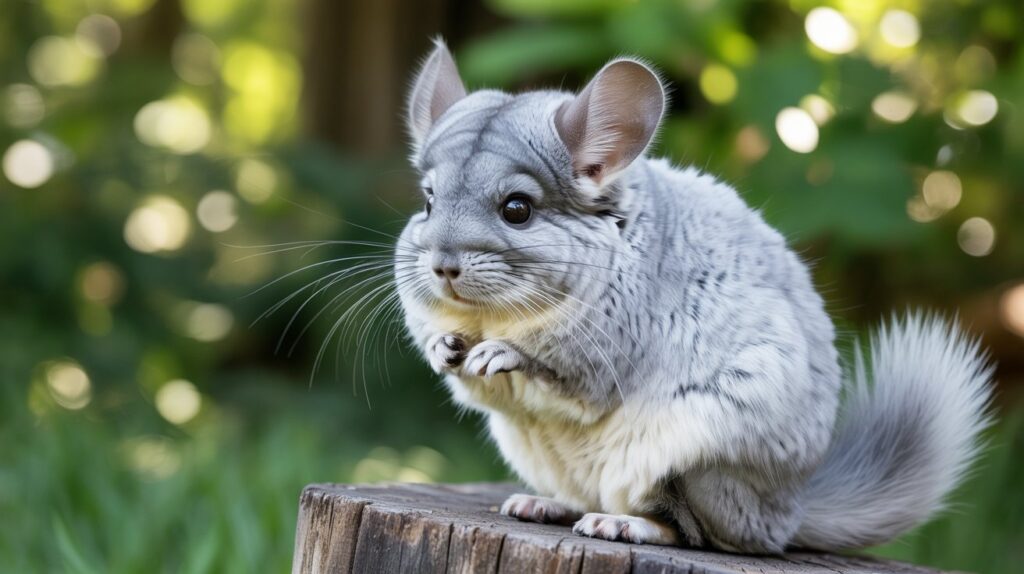Caring for chinchillas is a joyful responsibility. These small and fluffy animals are very sensitive to temperature changes. Because they have thick fur, they need extra attention in both hot summers and cold winters. If owners do not give the right care, chinchillas can become sick very quickly. This guide will help you understand how to keep your chinchilla safe, healthy, and happy throughout the year.

Table of Contents
1. Why Seasonal Care Is Important for Chinchillas
Chinchillas are native to the cool mountains of South America. Their thick fur keeps them safe in cold weather, but it also makes them sensitive to heat. In hot summers, they can easily suffer from heatstroke. In cold winters, they can get sick if their cage is not warm enough.
Because of this, every chinchilla owner should know how to adjust care during different seasons. Simple changes in housing, diet, and routine can keep your pet safe all year long.
2. Summer Care Tips for Chinchillas
Summer is the most dangerous season for chinchillas. Since their bodies cannot handle high heat, temperatures above 75°F (24°C) can cause stress or even heatstroke. Here are the most important summer care tips:
Keep the Room Cool
- Place the cage in a cool room away from sunlight.
- Use a fan or air conditioner to keep the temperature below 70°F (21°C).
- Never place the cage outdoors in summer heat.
Provide Cooling Tools
- Give chinchillas marble tiles or frozen water bottles wrapped in cloth. They can lie against them to cool down.
- Do not use ice directly because it can shock their body.
Fresh Water Supply
- Make sure they always have fresh, cool water.
- Refill the water bottle often because warm water loses freshness quickly.
Dust Baths in Summer
- Continue giving dust baths but only in a cool room.
- Limit the time to 10–15 minutes to prevent overheating.
Watch for Signs of Heat Stress
- Heavy breathing, lying flat, or refusing food are warning signs.
- If you notice these, move your chinchilla to a cooler place immediately and call a vet.
3. Winter Care Tips for Chinchillas
In winter, chinchillas face the opposite problem—cold weather. While they can handle cool climates better than heat, very low temperatures can cause sickness. Here’s how to keep them safe in winter:

Maintain a Warm Room
- Keep the cage in a draft-free room.
- Ideal winter temperature is between 60°F and 70°F (15°C–21°C).
- Avoid placing the cage near windows or doors where cold air comes in.
Safe Bedding and Warmth
- Use thick, soft bedding like fleece liners.
- Add extra hay for burrowing and warmth.
- Do not use heaters inside the cage, as they can cause burns. Instead, keep the room warm.
Dust Baths in Winter
- Continue dust baths but avoid cold or damp rooms.
- Make sure your chinchilla is dry before returning to the cage.
Prevent Illness
- Cold stress can lead to respiratory problems.
- Watch for sneezing, runny nose, or loss of appetite. If symptoms appear, seek a vet quickly.
4. General Care Tips for All Seasons
Some care tips are important throughout the year, whether it is summer or winter:
- Diet: Always provide fresh hay, pellets, and limited safe treats.
- Cage Setup: Make sure the cage is large, well-ventilated, and easy to clean.
- Exercise: Give chinchillas safe playtime outside the cage daily.
- Handling: Handle gently to avoid stress.
- Clean Environment: Keep bedding and cage clean to prevent bacteria and illness.
By following these tips, you create a healthy lifestyle for your chinchilla no matter the season.
5. Seasonal Routine Checklist for Owners
It is easy to forget small details, so here is a simple checklist for chinchilla care in summer and winter:
Summer Checklist
- Keep room under 70°F (21°C)
- Provide cooling tiles or bottles
- Refill water often
- Limit dust baths to cool rooms
- Watch for heatstroke signs
Winter Checklist
- Keep room draft-free and warm
- Add extra bedding and hay
- Give dust baths in warm space
- Monitor for sneezing or illness
- Avoid sudden temperature changes
Extra Seasonal Care Details for Chinchillas
Taking care of chinchillas in summer and winter is not only about room temperature. There are many small details that make a big difference in your pet’s health. Let’s explore some extra points every owner should know.
1. Importance of Air Circulation
Good airflow is very important for chinchillas in all seasons. In summer, poor air circulation can trap heat in the room, making your chinchilla uncomfortable. In winter, stale air can cause dampness and increase the risk of respiratory illness. Use a fan in summer but never blow it directly at your chinchilla. In winter, open windows for a short time to allow fresh air, but keep your chinchilla away from cold drafts.
2. Seasonal Diet Adjustments
While chinchillas eat the same basic diet year-round, you can make small seasonal adjustments. In summer, offer extra fresh hay to keep digestion healthy because heat can reduce appetite. You can also provide cool water more often, as chinchillas may drink more in warm weather. In winter, chinchillas may eat slightly more to stay warm. Always make sure their pellet portion is steady, and add extra hay to keep them satisfied. Avoid giving cold or wet vegetables in winter because they can upset the stomach.
3. Seasonal Cleaning Habits
Cage cleaning is another important part of seasonal care. In summer, dirty cages can smell worse and attract flies, so clean more often. Remove uneaten food quickly to prevent bacteria growth. In winter, damp bedding can become cold and cause discomfort. Change bedding often and make sure the cage stays dry.
4. Safe Playtime
Chinchillas love exercise, but the environment must match the season. In summer, allow playtime only in cool rooms, not during the hottest hours of the day. In winter, make sure the play area is warm and draft-free. Always supervise playtime so your chinchilla does not chew wires or unsafe objects.
5. Emotional Care in All Seasons
Chinchillas can get stressed if their environment changes too much. In summer and winter, try to keep a steady routine. Feed them at the same times, provide dust baths regularly, and spend time with them daily. A calm routine helps them feel safe even when the weather outside changes.
FAQs About Seasonal Care for Chinchillas
1. What is the best temperature for chinchillas?
The ideal temperature is between 60°F and 70°F (15°C–21°C).
2. Can chinchillas live outside during summer?
No, chinchillas should never live outside in summer because heat can kill them quickly.
3. How do I know if my chinchilla is too hot?
Signs include heavy breathing, lying flat, red ears, and not eating.
4. Can I use ice packs in the cage during summer?
You can use ice packs but always wrap them in cloth. Never place ice directly on your chinchilla.
5. Do chinchillas need heating lamps in winter?
No, heating lamps are unsafe. Keep the room warm instead.
6. How often should chinchillas have dust baths in winter?
2–3 times a week is enough, even in winter. Just make sure the room is warm.
7. Can chinchillas drink warm water in winter?
No, always give room temperature water. Warm water is not safe.
8. What bedding is best for winter?
Fleece liners and extra hay are safe and warm. Avoid cedar or pine bedding.
9. Do chinchillas grow a thicker coat in winter?
Yes, their fur becomes slightly denser, but they still need protection from cold drafts.
10. How can I keep my chinchilla safe during power outages?
In summer, move them to a basement or cool area. In winter, cover the cage with blankets (but allow airflow) and keep them in a warm room.
Conclusion
Chinchillas are wonderful pets, but they need careful attention in different seasons. In summer, keeping them cool is most important, while in winter, keeping them warm and draft-free is the key. By following these seasonal care tips, you can make sure your chinchilla lives a long, happy, and healthy life.


